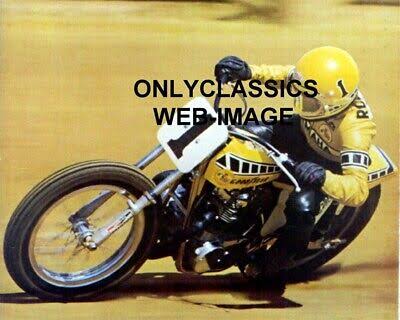
Ah Yes, the Legendary “They Don’t Pay Me Enough to Ride That Thing!” Moment — Throwback to 1975 When Kenny Roberts Faced the Beastly Yamahas
In the annals of motorcycle racing, few moments are as iconic—or as telling—as Kenny Roberts’ legendary reaction in 1975: “They don’t pay me enough to ride that thing!” The “thing” in question? Yamaha’s brutal, fire-breathing TZ750 flat track bike—an untamed machine with more power than control, and enough raw aggression to make even the bravest riders think twice. For Roberts, already making waves as one of the most talented racers of his generation, that moment wasn’t just a quip—it was a visceral reaction to a machine that was as much a challenge as it was a marvel of engineering.
By the mid-70s, Kenny Roberts was already known for his skill, fearlessness, and smooth style. He had made his name on the dirt ovals of the AMA Grand National Championship and was setting the stage for a career that would eventually change the face of Grand Prix racing. But in 1975, Yamaha had another idea: they wanted to put the ridiculously powerful TZ750 two-stroke road racing engine into a flat track chassis and see what would happen.
The result was something closer to a wild animal than a racing motorcycle. The TZ750 produced around 125 horsepower—absurd for a flat tracker at the time—and delivered it with the brutal immediacy that only a two-stroke can. Mounted in a relatively fragile dirt-track frame with no front brakes and limited suspension, it was less a racing bike and more a test of sheer will and reflexes.
Roberts was one of the few riders talented—and bold—enough to even attempt taming it. When Yamaha unveiled the bike and Roberts swung a leg over it, expectations were high. But after just a few laps, Roberts returned to the pits with the now-famous line: “They don’t pay me enough to ride that thing!” That raw honesty struck a chord, revealing just how close to the edge even the best riders felt when dealing with machines that pushed the limits of technology—and sanity.
But the story didn’t end there.
Despite his initial skepticism, Roberts did race the TZ750. And in a moment that would go down in racing history, he rode it to victory in the 1975 Indy Mile. Battling against lighter, more agile machines on a track where finesse usually beats brute force, Roberts piloted the monster Yamaha to a stunning win. Coming from behind in the final laps, he wrangled the beast with a combination of skill, guts, and sheer determination that cemented his legend.
“That race probably shouldn’t have been won by a bike like that,” Roberts later said, “but it was.” The moment showcased not just his talent, but also his adaptability and sheer will to win—qualities that would later make him the first American to win a Grand Prix World Championship in 1978.
The TZ750 dirt tracker was quickly banned—not because it wasn’t competitive, but because it was deemed too dangerous. In a sport defined by risk, that said a lot. And Roberts? He went on to become a global racing icon, known not only for his wins but for challenging the system, pushing boundaries, and speaking his mind.
Today, the phrase “They don’t pay me enough to ride that thing!” lives on as a symbol of racing bravado, honesty, and the fine line between genius and madness. It reminds us of an era when the machines were raw, the riders were fearless, and legends like Kenny Roberts defined what it meant to truly test the limits.
Leave a Reply